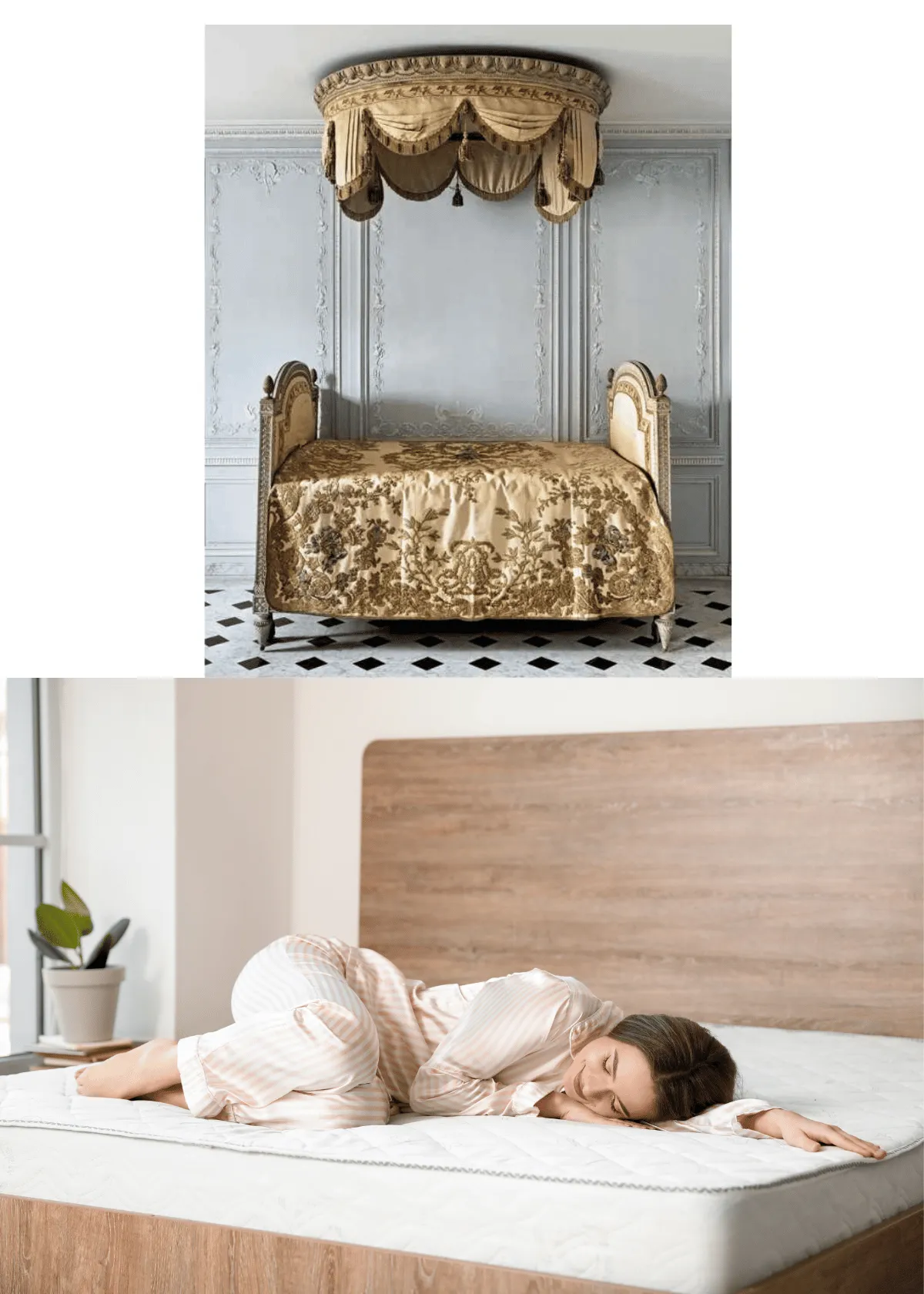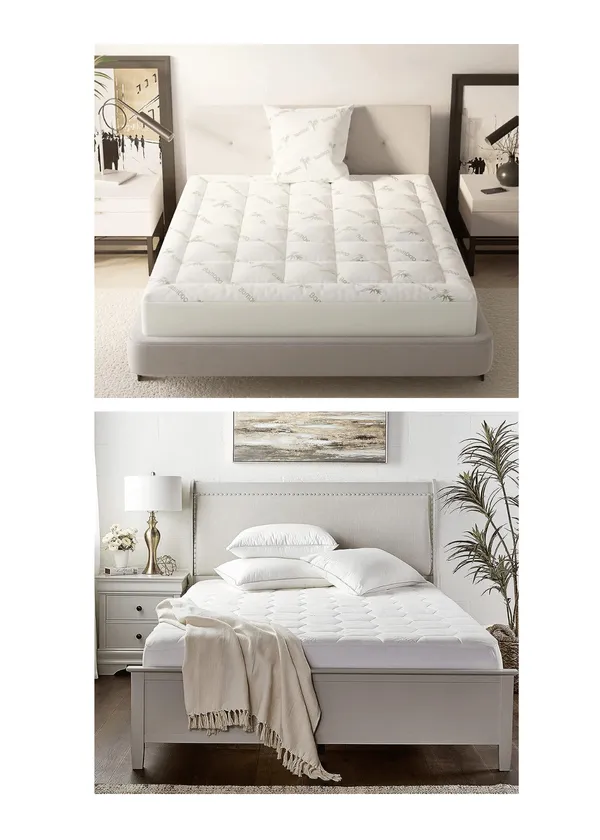(Last Update: 05/20/2024)
KEY TAKEAWAYS
- The history of mattresses and sleep has evolved over thousands of years, shaped by different socioeconomic statuses.
- Innovations in the market and industry have allowed for various options to cater to individual preferences and needs.
- Cultural influences, modern trends, and advancements in technology and materials are expected to continue driving the development of a more enhanced sleep experience.
Did you know that the history of mattresses dates back thousands of years?
The evolution of mattresses, from early humans sleeping in trees to the luxurious beds of ancient royalty, is fascinating.
In this blog post, I’ll explore how cultural and socioeconomic factors have shaped the development of mattresses from ancient history to today.
You’ll witness how mattresses have evolved to provide the utmost comfort and support for a good night's sleep.
Join me on this captivating journey through time.
SECTION 1: The Role of Sleep in Human Life and Health
Understanding Sleep-Wake Cycles in Human Beings
The concept of the sleep-wake cycle is fundamental to understanding human health and behavior. This cycle, which governs when we sleep and when we are awake, is a critical aspect of our daily lives.
Historically, the understanding of sleep-wake cycles has evolved significantly. In the early days, sleep was often segmented, with people experiencing 'first sleep' and 'second sleep' periods throughout the night.
However, in the last century, particularly in industrialized countries, the pattern shifted towards a consolidated night's sleep.
This change was documented in various medical texts and studies, reflecting human adaptation to changing lifestyles and environmental cues.
The Role of Sleep Regulation and Health Risks
Sleep regulation, a process controlled by the brain, is essential for maintaining overall health. Disruptions or light sleep in this regulation can lead to increased risks of various health issues.
Research from institutions like Stanford University has shown that irregular sleep patterns can contribute to chronic diseases, mental health disorders, and decreased life expectancy.
In the last two decades, there has been a growing focus on understanding the different stages of sleep, including REM (rapid eye movement) and deep sleep, and their impact on the body's vital processes.
This research underscores the importance of maintaining regular sleep-wake cycles for optimal health.
Sleep in the Context of Evolution and Modern Challenges
The study of sleep also extends to evolutionary perspectives, such as the sleep patterns of night-active animals and their influence on human sleep behavior.
In the last year, research has delved into how evolutionary needs and environmental factors have shaped our waking and sleep patterns.
This research provides insights into how modern challenges, like artificial lighting and shift work, have altered our natural sleep-wake cycles.
As we move into the future, understanding these aspects becomes crucial in addressing sleep-related health issues and improving the quality of life in our increasingly complex world.
The Dawn of Sleep Research and Medicine
T
I really like the fact that experimental sleep research and sleep medicine have evolved significantly.
We’ve transitioned from a rudimentary understanding of sleep to a sophisticated study of its complexities. In the early stages, sleep was a mysterious phenomenon with limited scientific exploration of its physiological functions.
However, as interest in understanding the human body and brain activity grew, so did the focus on sleep.
This marked the beginning of an era where sleep research became a distinct scientific discipline, laying the foundation for modern sleep science.
Pioneering Neurophysiological Studies in Sleep
The advancement of neurophysiological studies played a pivotal role in unraveling the mysteries of sleep.
Hans Berger, a notable figure in this field, made significant contributions with his invention of the electroencephalogram (EEG), which allowed researchers to study brain activity during sleep for the first time.
This breakthrough provided invaluable insights into the biological clock that regulates sleep-wake cycles, opening new avenues for understanding how the brain functions during different sleep stages.
Key Contributions by Sleep Research Pioneers
In the mid-20th century, he witnessed groundbreaking work by pioneers like Nathaniel Kleitman and his student Eugene Aserinsky.
Their discovery of Rapid Eye Movement (REM) sleep revolutionized the field of sleep science, revealing a complex and active brain state contrary to previous beliefs that the brain was passive during sleep.
This discovery laid the groundwork for further research into the different stages of sleep and their implications for health and disease.
Colin Sullivan's development of Continuous Positive Airway Pressure (CPAP) therapy for obstructive sleep apnea marked another milestone, showcasing the practical application of sleep research in treating sleep disorders.
Modern Sleep Science: Principles and Practice
Today, sleep science is an interdisciplinary field encompassing various aspects of medicine, psychology, neurology, and sleep physiology.
The principles and practice of sleep medicine now involve a comprehensive approach to diagnosing and treating sleep disorders, informed by decades of research.
Current sleep disorders research continues to build on the legacy of early pioneers, using advanced technology to study sleep and its impact on overall health.
This ongoing research is crucial for developing new and effective treatments for sleep disorders, furthering our understanding of this vital physiological function.
Section 2: The Evolution of Sleep
( Cultural Influences on Beds and Mattresses)
Throughout history, cultural influences have significantly shaped the evolution of sleep, beds, and mattresses. African, Middle Eastern, Eastern, and Western cultures exhibit distinct preferences for sleep surfaces and bed designs. Eastern cultures like Japan favor futons and daybeds, while Western cultures lean towards four-poster beds and canopies.
Cultural preferences extend beyond design and materials to sleeping locations, partners, and sleep schedules. This diverse range of cultural practices highlights how the richness of human experiences has profoundly influenced the development of sleep and beds over time.
The Etymology and Meaning of the Word "Mattress."
The word "mattress" comes from the French word "matelas" and the Arabic word "matrah." The first mattresses were made from straw, hay, and feathers. The Arabic word "matrah" means "something thrown down.” This is likely because the first mattresses were made from straw or hay, easily thrown down on the ground.

The first know mattress.
(Credit: National Geographic)
The Prehistoric Period:
(The Oldest Known Mattress (77,000 Years))
From the first mattress of human sleep patterns to the early medieval period to the luxurious beds of ancient civilizations and the Western world, the evolution of sleep and the history of mattresses span thousands of years.
The Sibudu rock shelter in South Africa is related to the first-ever mattress. In 2012, archaeologists discovered a 36-inch by 72-inch by 3-inch thick mattress made of compacted layers of plant material and grass at the Sibudu rock shelter.
Early humans initially resorted to sleeping in trees in prehistoric times, seeking safety from predators. As they evolved, they transitioned to sleeping on the ground. The oldest known "bed" dates back approximately 77,000 years ago and was discovered in KwaZulu-Natal, South Africa, making it the oldest known mattress worldwide. Early humans would sleep on a pile of leaves or grass mounded into a depression in the ground.
Let's explore the different periods and their contributions to developing beds and sleep.
Ancient Egypt
Ancient Egypt made significant contributions to the history of beds. Ancient Egyptians constructed raised beds with surfaces made of plain wood, keeping pests and snakes away from their feet. Ancient Egyptians raised beds by piling soil, sand, and sometimes linen sheets with stones or bricks. They added reeds, rushes, and straws to create comfortable sleep surfaces.

Pharaoh Tutankhamen's Bed.
(Credit:https://www.egyptabout.com
Ancient Africa
In addition to the prehistoric mattress found in KwaZulu-Natal, ancient Africa had diverse sleep practices. Tribes and communities used various materials for their bedding, such as grass, animal hides, and soft plant fibers. These materials provided comfort and insulation during sleep, adapting to the local climate and conditions.

An African Traditional Bed (Ngoni People).
(Credit: Izi Travel)
Ancient Arabic and Middle-Eastern
Ancient Arabic and Middle Eastern sleep history has unique characteristics. In ancient times, sleep in the region was influenced by cultural practices and Islamic traditions. According to legend, the first waterbed was developed in Persia more than 3,600 years ago and consisted of water-filled goatskins. The water was thought to have therapeutic properties and to help people sleep more comfortably. The first modern waterbed was invented in 1965 by California inventor Charles Halladay. Halladay's waterbed was made from a vinyl-lined canvas bag filled with water.
Sleeping arrangements often involved low wooden beds or mats placed on the floor, emphasizing simplicity and modesty. Privacy and comfort were valued, with expensive curtains and soft bedding materials like wool or cotton. These cultural elements contributed to the distinct sleep culture of the region.
Ancient Greeks:
Wealthy Greeks had more than one Kline; the Klines were couches with a raised headboard for reclining, eating, and sleeping. Some Klines were ornately decorated and upholstered with rich materials.
Ancient Rome (Circa 1,000 B.C. to 476 A.D.)
Ancient Rome showcased the distinction between the sleep arrangements of the wealthier citizens and the commoners. Wealthy Romans slept on beds filled with wool strings or feathers, while commoners made do with mattresses filled with hay. This disparity in materials reflected the socioeconomic divide in Roman society.
Ancient Eastern sleep history: China, Japan
Eastern world and culture have significantly impacted the development of beds and mattresses. For example, firm sleep surfaces are preferred in China. Meanwhile, in Japan, futons are commonly used for sleep, showcasing the unique preferences of Eastern cultures regarding beds and mattresses.
These cultural preferences also extend to other aspects of sleep, such as sleep locations and partners. For example, in some Eastern cultures, it is common for entire family or families to sleep together in one room, while in others, individuals may sleep in separate rooms. This diversity of preferences and practices highlights the profound influence of culture on the development of beds and mattresses throughout history.
Medieval Europe Period
(5th Century - 13th Century)
In medieval Europe, they introduced wooden beds and mattresses filled with straw or similar substances. Wealthier individuals in the Middle Ages enjoyed beds stuffed with soft, downy feathers, while the less fortunate had simpler bedding materials. Hang curtains enclosing all parts of beds provided privacy and protection from drafts for people of lower socioeconomic status.

Great Bed of Ware, England.
(Credit: Wikipedia)
The Renaissance (14th Century - 17th Century)
The Renaissance period is generally considered to have spanned the 14th to the 17th centuries. During the era of King Louis XIV, beddings like the four-poster bed became more ornate and elaborate. They were considered prized possessions. Four-poster beds with wood-paneled headboards and canopies supported by ropes or wool straps were popular. Socioeconomic status continued to influence sleep arrangements, with the wealthy owning intricately carved beds and thick, down-filled beds. Curtains were commonly used in bedrooms for privacy and protection from drafts. They were hung around beds to create separate spaces within the same room.

Renaissance Luxury Bedding.
(Credit: r Reilly Chanceliving
Enlightenment Period
( 18th Century)
During the Enlightenment, bed materials and support systems innovations emerged in the 18th century. Wool cushions, metal bed frames, and bedsprings were invented, replacing ropes or wool straps and providing enhanced support and comfort. This era laid the foundation for modern mattress designs and our wide range of options.

Marie Antoinette Bed.
(Credit: Chateau de Versaille)
Modern History
(19th Century; 20th Century - 21th Century)
Western cultures have also considerably affected the design and materials utilized in beds. This includes using wood, metal frames, and other materials to fabricate beds and other materials for comfort and aesthetics. In the modern world, the four-poster bed was still used in the 19th and 20th centuries but was less common than in previous centuries.
19th Century:
The 19th century witnessed a shift towards less ornate beds. Metal bed frames gained popularity due to their durability and affordability. Western European cultures influenced the design and materials used in beds during this period, introducing metal frames as a viable alternative to traditional wooden frames.
Although still used, the poster bed has become less common than in previous centuries. Scottish inventor John Boyd Dunlop invented the first latex mattress in 1888. Dunlop is best known for inventing the pneumatic tire, but he also invented the first latex bed from the sap of rubber trees.
20th Century until World War II Time Period.
During the 20th century, mattress materials evolved, incorporating technologies such as coil springs and cotton batting—the 19th c. The Industrial Revolution led to mass production, making beds more accessible to the general population. Cultural distinctions within Western cultures continued to influence sleep habits and preferences, with variations in sleeping arrangements, such as sleeping alone or with a partner or families in multiple rooms or beds.
21st Century:
There are many mattress options to suit every preference in this century. Modern mattresses incorporate advanced materials such as memory foam, latex, and hybrid designs.
Write 90 words Using “I” and “you” and their variants. You will incorporate personal pronouns into the text one or two times.
Use “I am thrilled to see that” in the content.
21st Century:
In this century, there are many mattress options in the modern era to suit every preference. Modern mattresses
Write 90 words Using “I” and “you” and their variants. You will incorporate personal pronouns into the text one or two times.
Use “I am thrilled to see that” in the content.
21st Century:
I am thrilled to see that there are many mattress options to suit every preference in this century. Modern mattresses incorporate advanced materials such as memory foam, latex, and hybrid designs. Sleep technology has also advanced, with innovations like adjustable bases, cooling features, and smart sleep trackers. Cultural influences and sleep practices worldwide have significantly shaped the design and comfort of contemporary beds. The evolution of beds and sleep throughout history reflects the impact of socioeconomic factors, cultural practices, and technological advancements.
Section 3: Innovations in the Mattress Market and Industry
The mattress industry has seen many innovations over the years, particularly during the 20th century, with each new development aiming to provide a more comfortable and supportive sleep experience. Some of the most notable innovations include innerspring mattresses, memory foam beds, and latex beds. These advancements in the 20th century have revolutionized our sleep, offering various options for individual preferences and needs.
In addition to these innovations, the mattress market and industry have also seen the emergence of hybrid beds, airbeds, and waterbeds. These unique bed options cater to various sleeping preferences and mattress sizes.
TECHNICAL AND MEDICAL ADVANCEMENT IN SLEEP
The Rise of Continuous Positive Airway Pressure (CPAP)
In the last few years, the field of sleep medicine has witnessed a groundbreaking advancement with the introduction of Continuous Positive Airway Pressure (CPAP) machines.
This technology has revolutionized the treatment of obstructive sleep apnea, a condition where breathing repeatedly stops and starts during sleep.
CPAP machines work by delivering a steady stream of air through a mask, keeping the airways open and ensuring uninterrupted breathing
. This innovation has improved sleep quality for countless individuals and reduced the health risks associated with sleep apnea, such as heart disease and stroke.
The Emergence of Sleep Labs
The establishment of sleep labs represents a significant leap in the practice of sleep medicine.
These specialized centers, which have become more prevalent in the second half of the last century, are dedicated to studying and treating sleep disorders.
The National Center on Sleep Disorders Research, NHLBI, NIH, supports research, technology innovation, training, and health education in sleep disorders.
In a sleep lab, patients undergo comprehensive evaluations, including polysomnography, to monitor various physiological parameters during sleep.
This allows for accurate sleep disorder diagnoses and effective treatment plans for various sleep disorders beyond sleep apnea. The growth of sleep labs underscores the increasing recognition of the importance of sleep health in overall well-being.
Addressing Daytime Somnolence and Shift Work
Another critical area of focus in recent sleep medicine advancements is the management of daytime sleepiness, especially among individuals working in two shifts.
Shift work can significantly disrupt the natural sleep-wake cycle, leading to sleep disturbances and excessive daytime sleepiness. Understanding the impact of irregular sleep patterns has become crucial in developing strategies to mitigate these effects.
This includes educating shift workers on sleep hygiene and exploring potential treatments to align their biological clocks with their work schedules.
The attention to these aspects highlights the evolving understanding that sleep matters in all facets of life, influencing both health and productivity.
Comparing Mattresses Throughout History
(Innerspring, Latex, Memory Foam)
Heinrich Westphal is credited with inventing the innerspring mattress in the late 19th century. Innerspring mattresses contain a system of metal coils or springs that provide support, offering a significant improvement over previous bed designs. Early innerspring beds utilized wool, down, or horsehair to encase the steel coil springs, ensuring comfort and support.

Stearns & Foster Serta Hurston Luxury Mattress.
(Credit: Stearns & Foster )
Innerspring mattresses have undergone several alterations, incorporating additional padding around the coils to enhance comfort. They gained popularity in the 1930s when the first box springs, springs, and spring platforms were developed for mattress support.
Today, the innerspring bed and the box spring remain popular due to their durability, support, ventilation, and general affordability compared to other mattress types.
NASA initially developed memory foam in the 1970s for airline seat cushioning and crash protection. The first memory foam mattress was introduced to the US market by TempurPedic in 1992, and it quickly gained popularity due to its ability to reduce pressure points and provide a comfortable sleeping surface.
Memory foam mattresses have high customer satisfaction, making them a popular choice for many individuals. Since their initial release, memory foam mattresses have undergone advancements in durability, breathability, and safety. As technology evolves, memory foam beds will likely continue to improve.
Latex mattresses have a rich history, with John Boyd Dunlop's invention of latex foam dating back to the 1920s. The first latex mattress was produced in 1931, and since the 1940s, latex foam beds have been in use, becoming popular in the 1950s and 1960s. Latex beds offer a unique combination of comfort and support and are more resilient than traditional beds.
Despite their initial popularity, latex beds experienced a decline in demand due to the affordability of memory foam mattresses. However, latex beds have recently experienced a resurgence in popularity, largely due to their longevity and the growing demand for natural, eco-friendly materials. As the bed market and industry evolve, latex beds remain viable for those seeking comfort, durability, and sustainability in their sleeping arrangements.
Section 4: Mattress Trends Today:
(Bed Frames, Hybrid, Latex, and Memory Foam Mattress)
The mattress industry has recently seen a surge in new trends and innovations. Among these modern trends are hybrid beds, airbeds, waterbeds, and eco-friendly materials in mattress construction. These contemporary mattress options cater to a diverse range of sleeping preferences, allowing individuals to find one bed with the perfect balance of comfort and support for their unique needs.
The rise of online sales and the emergence of new mattress brands, such as Casper, Leesa, and Tuft & Needle, have also contributed to the ever-evolving landscape of the market and industry.

Tempur-Pedic Adapt11 Queen Mattress.
(Credit: Tempur-Pedic)
Mattress Sizes and Innovation:
Different mattress sizes were invented to meet the needs of different people and sleep arrangements. The first standard mattress sizes were invented in the early 1900s, larger sizes in the mid-1900s, and the split California king in the late 1990s.
The Major Contribution of Hybrid Mattresses in the History of Sleep
Comfort and Support
Hybrid mattresses have significantly contributed to the history of sleep by revolutionizing the concept of comfort and support in bed. By combining different materials such as foam, latex, and innerspring coils in a multi-layered bed design, the bed offers a unique sleep experience. Integrating multiple materials into platform beds allows for a balance between contouring comfort and responsive support.

Van Vorst Mattress.
(Credit: Van Vorst)
Versatility and Adaptability
One of the key contributions of hybrid beds is their versatility and adaptability. Combining various materials enables hybrid mattresses to provide a customized sleep surface that caters to individual preferences.
With different layers and varying firmness levels, individuals can choose a hybrid mattress that suits their needs, whether they prefer a plush feel or firmer support. This versatility ensures that hybrid beds can accommodate a broader range of sleepers.
Continuous Innovation
Hybrid beds have sparked a wave of innovation in the market and industry. Their success has prompted manufacturers to continually refine and improve the design and materials used in hybrid beds.
This ongoing innovation has led to advancements in foam technology, coil systems, and the integration of new materials, resulting in even more comfortable and supportive sleep surfaces. Hybrid beds have pushed the boundaries of sleep technology, inspiring other mattresses to incorporate similar hybrid approaches.
Scientific discoveries about sleep
Scientific research has significantly advanced our understanding of sleep, revealing the complexity of the sleeping brain.
Brain wave patterns shift as we transition into sleep, marking the journey from wakefulness to NREM sleep, a crucial restorative phase. Studies highlight the importance of sleep hygiene in maintaining a healthy circadian rhythm, which is essential for getting enough sleep.
The concept of biphasic sleep, sleeping in two phases, aligns with natural circadian rhythms, optimizing rest.
External stimuli can disrupt these patterns, underscoring the need for a conducive sleep environment.
Airbeds and Waterbeds and Eco-Friendly Materials
Airbeds, also known as air mattresses and waterbeds, are unique mattress options that have existed for quite some time. Waterbeds were first introduced in the late 1960s and gained popularity in 1980 and the following years, while the first airbed was manufactured by Comfortaire in 1981.
Besides loft, futon, and wrought iron, there are other types of beds in the mattress market and industry, like box spring beds, platform beds, waterbeds, Murphy beds, storage beds, bunk beds, divan beds, and pull-out sofa beds. These beds offer a distinctive sleep experience, catering to a niche market of individuals seeking an alternative to traditional mattress types.
While they may not suit everyone, airbeds and waterbeds offer a unique and comfortable sleep solution for those seeking something different in their bed box linen sheets and bed.
The use of eco-friendly materials in mattresses has gained traction in recent years as consumers become more conscious of the environmental impact of their choices. Eco-friendly materials in contemporary beds include natural latex, organic cotton, wool, and bamboo.
These materials are more sustainable and often more breathable and comfortable than traditional mattress materials.
While eco-friendly materials may sometimes be more expensive than traditional materials and may have different longevity, they offer a more environmentally friendly option for consumers looking to reduce their ecological footprint. As the demand for sustainable products grows, eco-friendly materials will likely become an increasingly popular choice in the mattress industry.
Understanding and Diagnosing Sleep Disorders
The Spectrum of Sleep Disorders
Sleep disorders involve many conditions that affect sleep quality, timing, and duration, impacting overall health and well-being.
Common sleep disorders include obstructive sleep apnea, characterized by repeated breathing interruptions during sleep, and insomnia, marked by problems of falling asleep or staying asleep.
Other sleep disorders, like narcolepsy and restless legs syndrome, also significantly disrupt any normal sleep pattern of eight hours. Understanding these disorders is crucial for effective treatment and disease control.
Diagnosing Sleep Apnea and Its Variants
Obstructive sleep apnea (OSA) and central sleep apnea are the two main types of sleep apnea, with OSA being more common.
These conditions are characterized by pauses in breathing or shallow breathing during sleep, which can lead to sleep disturbances and excessive sleepiness during the day.
Diagnosing sleep apnea typically involves a sleep study or polysomnography, which records various physiological functions during sleep, such as brain activity, eye movements, and breathing patterns.
The multiple sleep latency test is another diagnostic tool for assessing daytime sleepiness.
The Role of REM Sleep and Sleep Stages in Disorders
Rapid Eye movement (REM) sleep and slow wave sleep are critical sleep cycle stages. REM sleep is associated with vivid dreams and is thought to play a role in memory consolidation and emotional regulation.
Disorders affecting REM sleep, such as REM sleep behavior disorder, can lead to physical movements during dreaming and disturbed sleep.
Slow-wave sleep, or deep sleep, is essential for physical restoration. Disruptions in these stages can lead to various sleep problems, including segmented sleep and pathological sleep patterns.
The Impact of Sleep Disorders on the Nervous System
Sleep disorders can have a profound impact on the nervous system. Conditions like sleep deprivation and chronic insomnia can lead to cognitive impairments, mood disturbances, and an increased risk of neurological disorders.
Lesion studies and research into the neurobiology of sleep have provided insights into how sleep disorders affect the brain and nervous system.
This research is essential for developing effective treatment options for sleep-related neurological issues.
Modern Approaches to Treating Sleep Disorders
The treatment of sleep disorders has evolved significantly over the years. Continuous positive airway pressure (CPAP) therapy is a popular and effective treatment for obstructive sleep apnea.
Other treatment options for various sleep disorders include behavioral therapy, medication, and lifestyle changes. Sleep disorders centers are crucial in providing comprehensive care, from diagnosis to treatment, ensuring that patients with sleep disturbances receive the most appropriate and effective interventions.
As our understanding of sleep and wakefulness deepens, so does our ability to offer more targeted and effective treatments for those suffering from sleep disorders.
Section 5: The Future of Sleep and Mattresses
Throughout sleep history, the evolution of beds and mattresses has been shaped by various factors, including cultural influences, technological advancements, and changing consumer demands. In this context, smart and adjustable beds represent the latest innovations contributing to sleep's evolution.
Smart mattresses with advanced technology features integrate seamlessly into the sleep experience. They offer a range of functions, such as sleep tracking, temperature control, adjustable firmness, and connectivity options. By incorporating these features, smart beds aim to provide personalized comfort and optimize sleep quality.

Eight Sleep Pod 3.
(Credit: Eight Sleep)
On the other hand, adjustable beds focus on the positioning and customization of the new bed and sleep surface. With motorized bases, these bed users can adjust the angle and elevation of the bed in different sections, offering versatile options for reading, watching TV, or finding the most comfortable sleep position. Adjustable beds provide enhanced support and can help alleviate certain health conditions.
Both smart mattresses and adjustable beds represent the latest advancements in the quest for improved sleep. They showcase technology's influence in meeting sleepers' evolving needs and preferences.

Sleep Number 360 i8 Bed.
(Credit: Sleep Number)
Summary
The history of sleep and mattresses is truly fascinating.
From early makeshift beds to luxurious modern mattresses, we see how our quest for comfort has evolved.
As we embrace new technologies and adapt to changing consumer demands, the future of sleep and mattresses promises to be even more exciting.
Let’s work together to create a future where everyone can enjoy the perfect night's sleep.
Join me in exploring how we can continue improving our rest.
Frequently Asked Questions
How has the mattress changed over time?
Over time, the traditional mattress has become more advanced and comfortable. From thinner mattresses in the 1980s and 1990s that suffered from motion transfer issues, recent advancements have seen the average mattress height increase considerably, allowing for improved durability and comfort.
This has resulted in a much more comfortable sleep experience, with most mattresses now offering superior support and pressure relief. Additionally, using advanced materials, such as memory, is an advantage.
What is the brief history of mattresses?
Mattresses have a long and rich history. The first mattress was believed to have been created by humans living in Sibudu Cave in KwaZulu-Natal, South Africa, around 77,000 years ago. This ancient mattress was made of layers of plant material and grasses for bedding.
What did people sleep on before modern mattresses?
People have been sleeping on mattresses for centuries, though what constitutes a comfortable mattress has drastically changed. Before modern mattresses, people typically used soft bedding materials such as reeds, rushes, leaves, straws, woven mats, and cloth sacks filled with hay. This provided a more comfortable environment than people sleeping directly on the ground.







